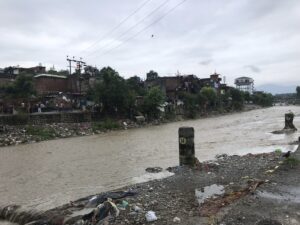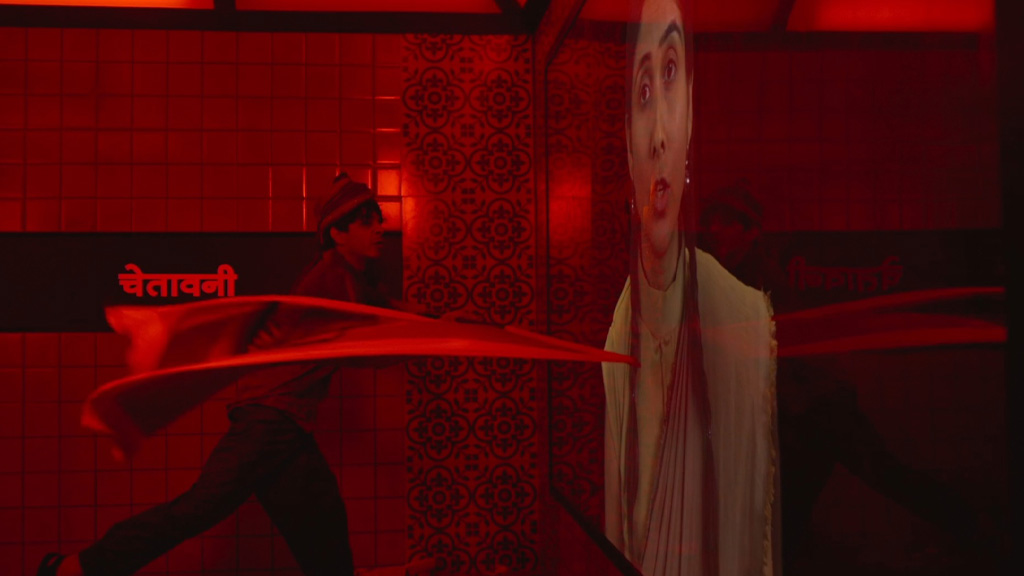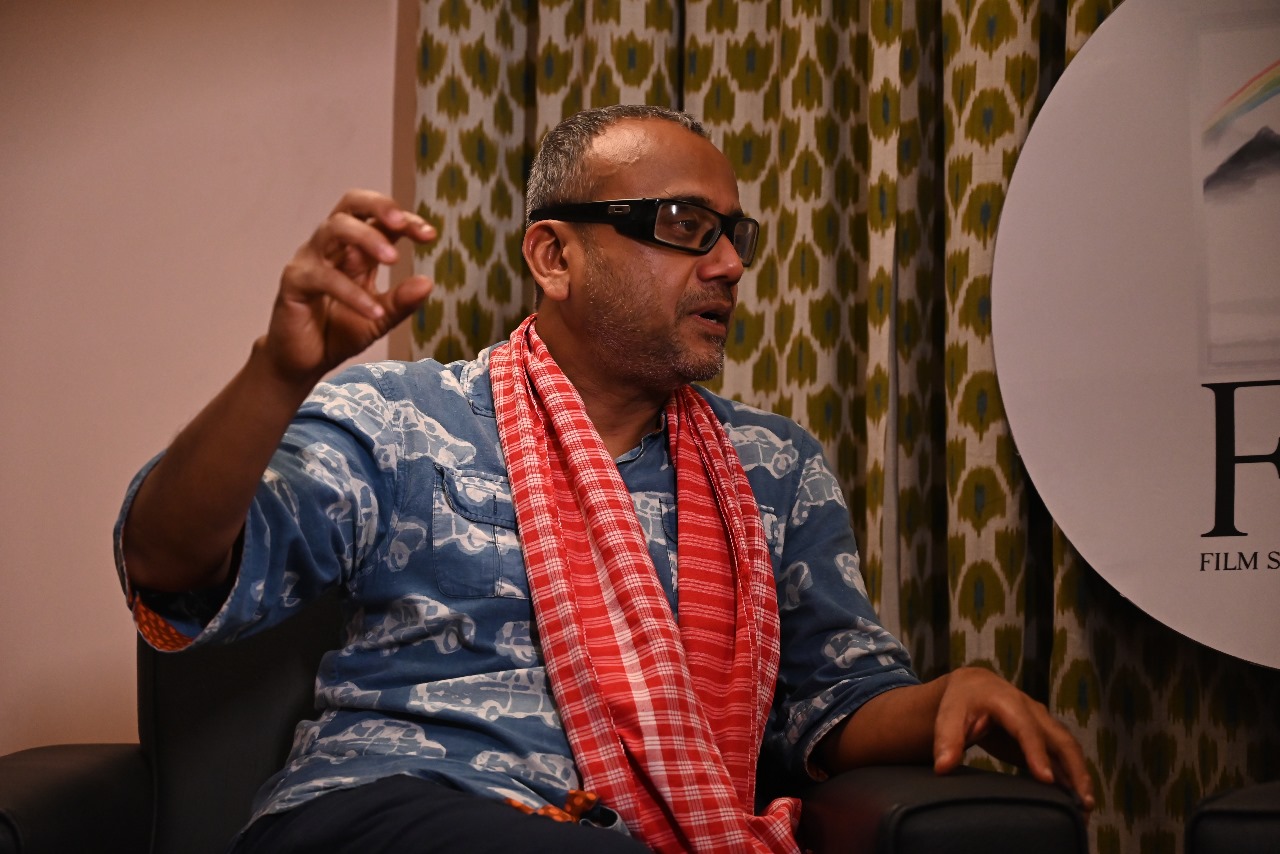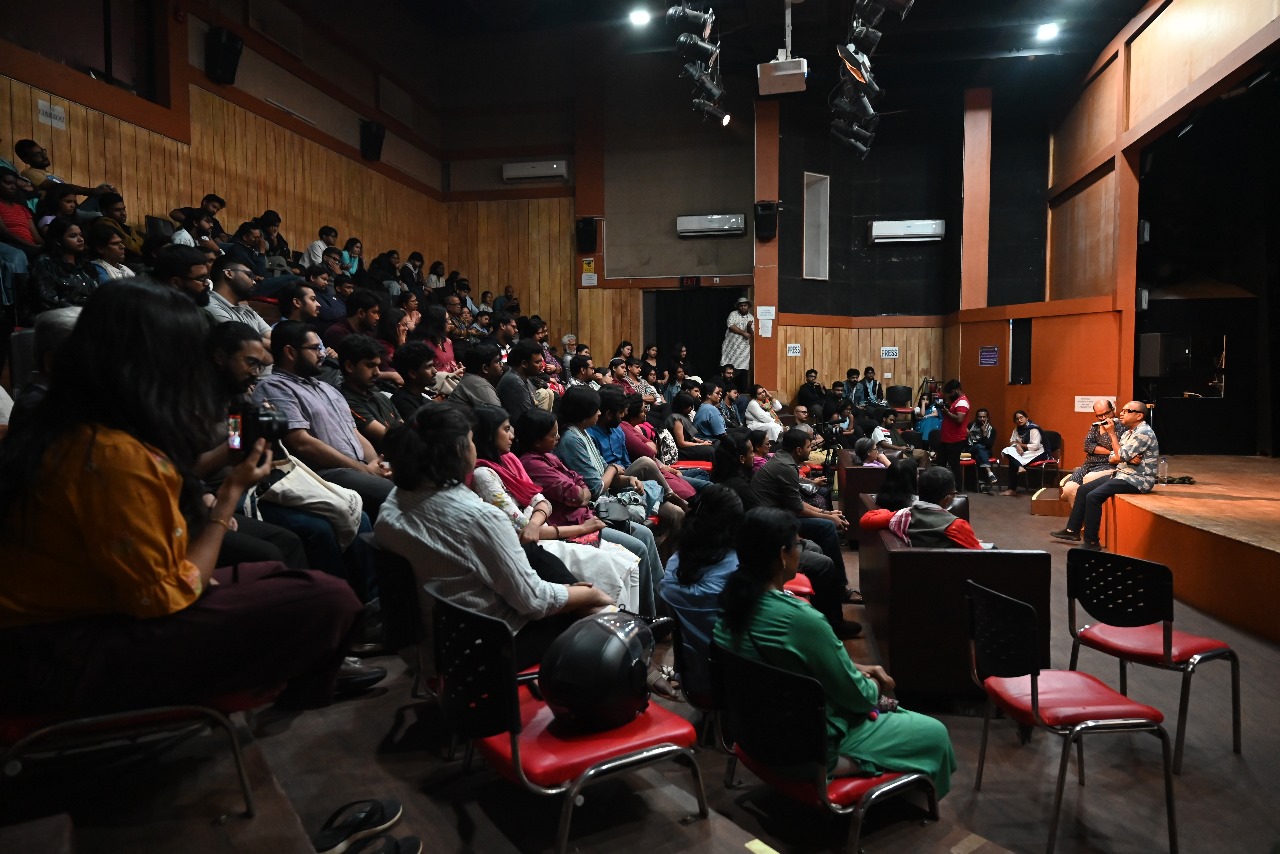
“It’s a Rather Perverse Vindication of My Film”: Dibakar Banerjee on Tees, Censorship, and Cinema

When you think of the enfant terrible of Hindi cinema, a name like Anurag Kashyap might spring to mind. Dibakar Banerjee is not synonymous with release troubles. The filmmaker, who changed the language of Hindi mainstream cinema in the late 2000s, is prone to awe more than shock; his films operate in the popular spheres even as they gently question rigid social entities in modern India.
He began with satirical comedy that poked holes in the post-liberalization story of the Indian middle class—Khosla Ka Ghosla (2006) and Oye Lucky! Lucky Oye (2008)—and moved to more realistic sociopolitical genre benders in Love Sex Aur Dhoka (2010) and Shanghai (2012). A detour to a stylized adaptation of Detective Byomkesh Bakshy (2015) later, his Sandeep Aur Pinky Faraar (2021) reimagined romance as a road trip with a lifetime of baggage.
In a career spanning multiple roles—producer, screenwriter, lyricist, director—Banerjee has taken a public position over the rising violence in the country against religious minorities and attacks on students since 2014, even returning his National Award in 2015 along with 12 other film directors. Today, his name rises with a wistful sigh—a strange mix of anger and longing. His tenth film, Tees, was ready for release at the end of 2022, but Netflix India, the platform that commissioned it, developed cold feet.
Tees observes one family across three generations. It is a scathing look at the idea of India as it went through a tectonic shift in its image from the largest secular democracy to a Hindu Rashtra. The film delineates the movement of the ideological needle in the country, from the beginning of the 1990s to the present day of rampant Islamophobia, and also imagines the future beyond.
By the end of 2022, the fascist atmosphere in India was evident to all. With Hindi cinema toeing the government’s line and even offering itself up as a tool for pamphleteering, the film world refused to dissent against the BJP’s then eight-year strong run. They observed that controversy, raids, or arrests followed cinema that didn’t sit well with the dispensation, exemplified by the fiasco around the Amazon Prime Video series, Tandav (2021), and the arrest of Shah Rukh Khan’s son Aryan Khan.
So, many Kashmir and Kashmir-adjacent stories, for example, have been made into propaganda films that follow the Hindu Rashtra diktats of the BJP government, from Uri: The Surgical Strike (2019) to The Kashmir Files (2022) to Article 370 (2024) to Fighter (2024). This does not include the ahistorical films based on Hindu kings’ valor against Muslim (mostly Mughal) rulers, as seen in Chaava and other fictionalized nationalist films based on spy craft, politicians, and historical tragedies such as the Jallianwala Bagh massacre.
With Tees, Netflix dragged its feet. Although Banerjee offered to trim portions himself, there was simply no release plan, so he had to get the film out of Netflix’s hands for exhibition in festivals, universities, and community screenings. In 2024, Tees premiered at the Dharamshala International Film Festival. Yet, as of 2025, it has joined a laundry list of films and shows in cold storage on streaming platforms and studios.
Tees is a searing critique of the state and the people, and in its present form, a red flag for the Indian censor board and the government. Among several things, it is an exploration of Kashmir through an anthological lens to reveal the story of India. In January this year, Dibakar Banerjee brought Tees to the Indian Film Festival Bhubaneswar. As co-organizers and curators, we had the opportunity to do a post-screening Q&A and an interview with the filmmaker.

Moving Gracefully Between Timelines
Tees opens with a digital avatar called Bheegi Billi. The year is 2042, and we are in dystopian New Delhi. Anhad Draboo (Shashank Arora) is a sex worker soliciting through an app, but he is also a writer. He is, ironically, the author of Tees, an unpublished work that didn’t see the light of day owing to the stringent censorship rules.
In 2042 India, segregation is stark, and metropolitan living conditions are so claustrophobic that celebratory processions occur in the underground metro. Though we enter the world of Tees in the future, Banerjee’s film crisscrosses timelines. From the future we go to the past in 1989, or sometimes the present, in 2019. There is no order in the way the story moves around, creating a temporal melange that comes together as a potent monument to memory.
In Mumbai of 2019, we have Zia (Huma Qureshi), Anhad’s mother, a corporate lawyer who lives with her partner Meera. The queer relationship isn’t the problem, it is her Muslim name—one beginning with Z instead of J like a broker tells her—that comes in the way of buying a house.
A Kashmiri family in Srinagar in 1989 closes the loop, or rather, they are the progenitors of this intergenerational story. Ayesha (Manisha Koirala) is a matriarch who runs the house while moonlighting as a radio artist. She belongs to a particular nouveau Muslim elite of Kashmir, living a comfortable life with her husband Gul (Neeraj Kabi) and daughter Zia, a house-help Gasha, and best friends in Usha (Divya Dutta) and Usha’s Kashmiri Pandit family.
Each segment has a particular look; the Srinagar segment is colored by bluish tones, the Mumbai segment is warmer, and Delhi has the metallic look of dystopia. The timelines also have their own auditory signature—Srinagar has the dominance of Kashmir Radio, while Delhi has the announcements of the “Great Leader”, the underground train station warnings, and the holograms providing messages.
“I am proud of the sound in the Kashmir section,” Banerjee told us. “Everything you hear from All India Radio or Radio Kashmir, as it was called, is authentic and re-recorded.” Banerjee and his team specifically sought out artists for this. Arshad Mushtaq, a playwright and scriptwriter from Srinagar, collaborated with announcers. musicians. traditional Kashmiri actors and playwrights to design the soundscape of the radio in 1989, with talk shows, choirs, and other features.
“In some ways, it is preservation,” Banerjee said. “The plays that you hear, the music…”
If physical space and freedom contract from 1989 through 2042, the sound design in Tees complements the disorder and turmoil in daily life. Radio Kashmir in Srinagar, a pleasant presence that indicates moments of calm before the storm, while in 2019, there is a constant drone that disrupts mental peace. In 2042, it’s noise everywhere from the metro to Anhad’s slum—of processions, announcements, and political sloganeering.
Tees moves gracefully between timelines, the film even attaining the structure of a novel. As generations collide in political and personal upheaval, their stories realize larger import in a fractured society. Ayesha is the matriarch who survived all these decades, and we see her still alive and living with her grandson, Anhad, a love child of Meera and her paramour, whom she and Zia are forced to adopt. The three time periods operate like a weave; they move into each other as a tapestry, the past informs the future, a flutter in one life creating a storm in another. We make the connections and draw out the relationships, needing multiple viewings to unpack the layers of sound and image.
The Quintessential Indian Experience
Tees is the portrait of the slow disintegration of the Indian family, once secular, that atomizes into discombobulated parts though unlike one another, carry the ghosts and trauma of each other. A geopolitical time bomb that exploded in the 1980s has affected the personal and political lives of every subsequent generation. Ayesha embodies all of this.
Anhad cannot tell his own story, nor catch a break in his artistic endeavors, thanks to his identity. In addition to her sexuality, Zia’s Muslimness becomes detrimental in a city far away from her homeland, and none of Ayesha’s efforts to decouple their legacy from that of Kashmir come to the aid of her daughter.
“It is the quintessential Indian experience,” Banerjee said, explaining how Ayesha is like his parents in the 1980s: a woman who finds her feet in a patriarchal society but remains apathetic towards the plight of other marginalized groups, in her case, the Kashmiri Pandits, whose exodus she chooses to turn away from.
In 1989, in Srinagar, we see a busy Ayesha in a traditional Kashmiri house, trying to raise a family in a difficult time. The Kashmir self-determination movement, which was earlier nationalist in character, became separatist and extremist. 1989 is also the year when the movement became an armed struggle against the Indian state, Kashmir ultimately becoming one of the most militarized spots in the world today.
Tees is subtle about these larger issues, only showing how this impacts Ayesha’s job at the radio station and her husband’s printing press, threatened with a bullet in a letter. There are targeted public executions in the market. Ayesha even mentions the killing of a retired judge.
The Mumbai segment is shot entirely within a gated community. We see little of the city when Zia is house-hunting. She wants to avoid the ghettos; the Mumbai of 2019 is deeply segregated against the Muslim population. The impact of over two decades that have passed—since the 1992 demolition of the Babri Masjid and the subsequent riots, followed by the ascent of the BJP in 2014—is lethal and malicious. This is further pronounced by the revocation of special status to Jammu & Kashmir under Article 370 in August 2019. Meera talks about the 18 month-long internet blockade with Zia.
“The triggering event for this [film] was Gauri Lankesh’s murder [in 2017],” Banerjee said during the post-screening Q&A in Bhubaneswar. By 2018, he had a basic story, structured around the son, mother, and grandmother—three stories told successively. A fellow filmmaker suggested to Banerjee to interweave the narratives, instead. Banerjee loved the idea and began developing the script with writer Gaurav Solanki, who’d previously worked on Tandav and Anubhav Sinha’s 2019 political thriller, Article 15.
Banerjee wondered how they could ensure that interspersing one character’s life with another wouldn’t disorient the audience. “We decided that these three stories are distinct, but they combine and form a fourth story, the super story,” he told us, referring to the film itself as a whole. “Structurally, that’s what we were aiming for.”
Putting the Idea of “Home” to the Test
Tees uses the Kashmiri Pandit exodus of 1990 to question the gradual passage to statelessness for the Muslim individual in India. With the atmosphere of fear and the exodus imminent, we feel Usha’s waning hope and latent cynicism in her relationship with Ayesha, a companionship cultivated since childhood. The growing distance leads to Usha’s sudden disappearance from the film as we follow Ayesha and her family, even as their identity as Muslims and belonging in the Indian state becomes more and more challenging with each passing decade.
This is the entity that Banerjee puts to the test in Tees: home. The idea of a bond to a place, an emotional attachment to a physical location. So much that while 1989 is about a ravaged home, 2019 is about finding a place to live, and 2042 is all-out segregation. The latter two segments are so confined to interiors and tiny spaces that the film becomes a chamber drama. But Banerjee did cheekily admit that the look and feel of the 2042 setting was a consequence of shooting under lockdown and COVID-19 guidelines.
In 1989, the home was sacred, happy, and fulfilling. Ayesha hosts a feast and converses on the phone with long-lost friends. Kashmir, even if on the brink of volatility, remains livable for a moderately privileged bourgeois family. Ayesha and Usha talk about a cookbook to preserve Usha’s Kashmiri recipes. What is home if not its food and culinary culture, and practices? What is a family if not for the food on their table?
This is the point where we first see fissures. Usha brings up the bugaboo: the growing insurgency in the state, and the impending danger for the Pandits. For her, where is food and preservation when a home is on the verge of extirpation? Through this story, Banerjee’s visual grammar is dynamic; the handheld camera glides through every room, it goes outside and returns to rest on Ayesha as she picks up and talks on the phone, or zooms into her face as we listen to her conversation with what we know as only a voice.
In 2019, as the nation is about to erupt against the Citizenship Amendment Act, Zia is unable to even find a home to live in, a time when Independence Day celebrations in insular gated townships get a saffronized, unsecular flavor. Tees illustrates the intergenerational trauma of a lost home with a serpentine single take pressed over Zia’s face as we listen to Ayesha, on the faceless end of the phone line now, calmly talk Zia out of a panic attack. A lot of mainstream art focuses on physical violence—much simpler to depict, but Tees is one of those rare films that also centers the mental health toll of the othering that is rampant in the country today.
In 2042, the segregation is starker, a home is any ten square feet box, a shabby, constricted New Delhi that is further ghettoized, a city where not only air is rationed, but you need special privileges for different parts of the city. Anhad lives in a slum, sharing it with a weathered Gasha (Naseeruddin Shah). Gasha, like Ayesha, is the only other character who has seen it all from 1989 to 2042, from the insurgency and exodus to the loss of a republic, his acerbic humor a mark of the ravages of time. He once knew a self-sufficient home, but here, he is sharing it with that family’s third-generation successor, fighting over the toilet.
Banerjee visualized the scenario in such a way that whatever happened in India between 2020 and 2030 becomes the foundation of the state in 2042. In the setup he imagined, the last partially successful election took place in 2028, installing a weak centrist coalition that broke down to give way for martial law. In a stage-managed election that followed, the only person to stand wins and their appointees then continue that legacy.
Banerjee is on solid ground imagining the future, as noted political thinker Yogendra Yadav remarks in his 2020 book Making Sense of Indian Democracy that India’s political system can best be described as “competitive authoritarianism”, wherein “elections would be held without fail, but only in order to affirm the supreme leaders’ popularity. Any form of political contestation outside the electoral arena—dissent, protests, and human-rights struggle or civil-society activism—would be ruthlessly suppressed.” Yadav also points to the rendering of “minorities, mainly Muslims and Christians, to the status of second-rung citizens.”
In essence, he writes, “We may be looking at the mutilation of the idea of India.”
Blurring the Lines Between Film and Reality
“A dictatorial government, which is suppressing art, is also wanting to employ storytellers to tell stories that will perpetuate its own power,” said Banerjee. “This is a conundrum that I think every developed dictatorship faces before the society is destroyed.” He is referring to the dystopian future scenario in Tees, but he could just as easily be talking about India today.
In the film, Anhad is a failed novelist. His book Tees didn’t pass the censorship as it is a detailed account of the riots of 2030, and the film suggests that this incident took the lives of Zia and Meera. The film portends a situation where there is an intense longing for “good” (as the state defines it) art and artists to get across the regime’s message. In a farcical turn of events, the government courts Anhad to write books to instill intelligence and enlightenment in its people. Even to sustain the most insidious ideas, art is necessary. All three stories ring true, but 2042 is particularly funny, satirical, and darkly comic.
Even as Tees languishes in bardo, self-censorship is now the norm in India. Several recent films ran into trouble either clearing the Censor Board of Film Certification, blocking their release, or are in the vaults of studios and streaming platforms owing to self-censorship induced by the climate. Arun Karthick’s Nasir, Sandhya Suri’s Santosh, Honey Trehan’s Punjab ‘95, and Natesh Hegde’s Pedro are among the films that have never seen the light of day for public exhibition.
Even an international series like The White Lotus isn’t spared, one that streams directly to people’s homes and devices.

If Tees had released, Banerjee said, he wouldn’t be here in Film Society Bhubaneswar. Just like how completely disparate things occur in the lives of Ayesha that have a domino effect on Zia and Anhad, Banerjee wonders about his newfound rebellious status. “Suddenly this happened to me and now I’ve woken up to collective action and I am going on talking about the country and where it is going.”
Anhad Draboo’s unpublished novel begins with the poet Agha Shahid Ali’s words, “My memory keeps getting in the way of your history.” The Indian state attempts to block the memories of its population to rewrite its history. Even as Tees remains unseen, the government’s facade of a transformed, travel-friendly Kashmir took a hit in the last two months.
The attack in Pahalgam was followed by brazen fanning of hatred against Muslims across India, even as the country was considering its response. The four-day escalation between India and Pakistan recalls Ali’s words from his Farewell: You make desolation and call it peace.
Banerjee has come to share Anhad’s fate. “I didn’t intend this film to be semi-autobiographical,” Banerjee said, noting the irony. “It’s a rather perverse vindication of my film.”
But for Banerjee, these questions of distribution don’t really matter. “What matters is that the film is made,” he said, “and what matters is that people in communities are discussing [it].” He insists on his trust in community initiatives for the future.
“Maybe we will never reach Bombay Times or top news portals of the country,” he added. “We’ll be under the radar … We must keep pushing for this community action.”





